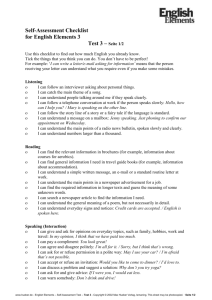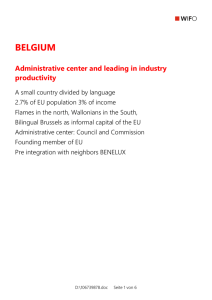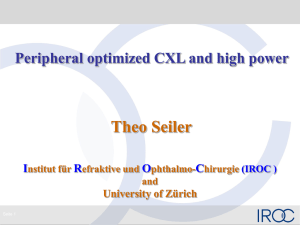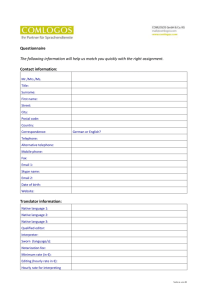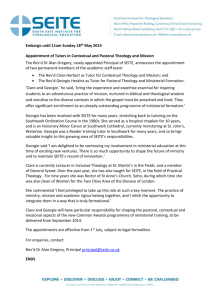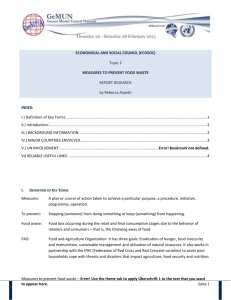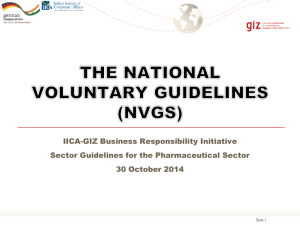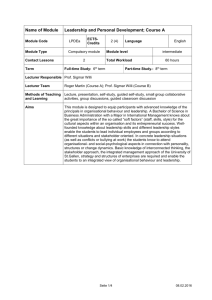Ministry Council - The Church of England
advertisement
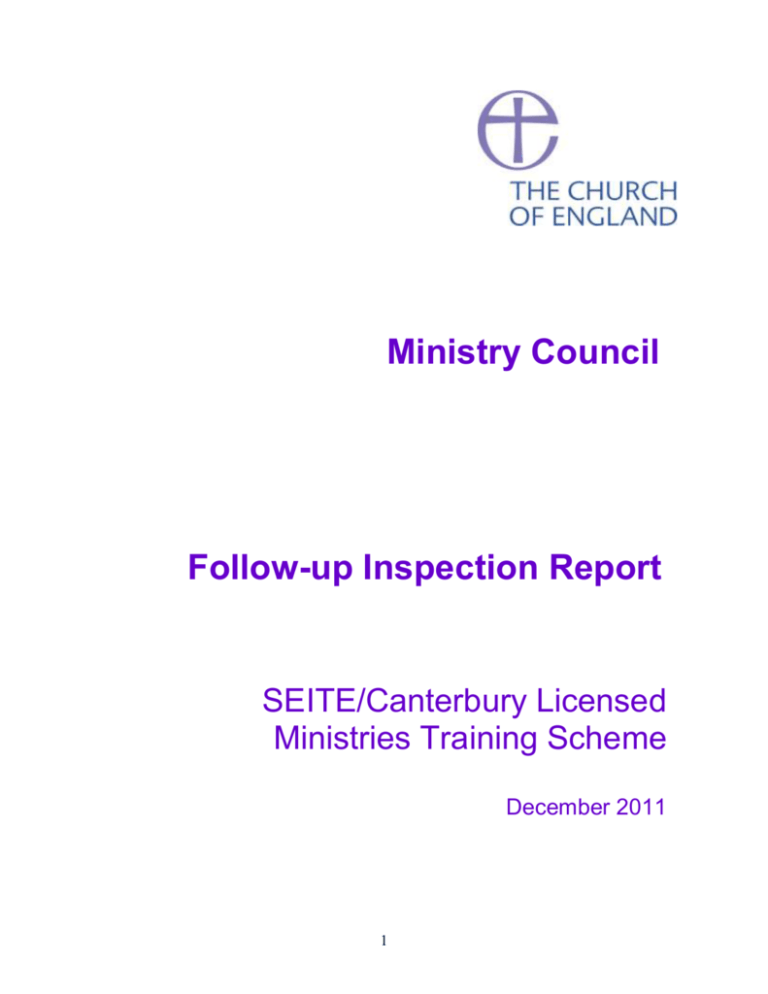
Ministry Council Follow-up Inspection Report SEITE/Canterbury Licensed Ministries Training Scheme December 2011 1 Ministry Division Church House Great Smith Street London SW1P 3AZ Tel: 020 7898 1412 Fax: 020 7898 1421 Published 2012 by the Ministry Division of the Archbishops’ Council Copyright © The Archbishops’ Council 2012 2 SEITE/Canterbury Licensed Ministries Training Scheme Inspector’s follow-up Report on the Response from the South East Institute for Theological Education (SEITE) to the Recommendations of the Inspectors’ May 2010 Report on the Canterbury Licensed Ministries Training Scheme, and on SEITE’s implementation of its August 2010 Action Plan November 2011 INTRODUCTION The inspection of the Canterbury Licensed Ministries Training Scheme (LMTS) took place in February-May 2010 and the Report was published in July 2010. It returned an overall ‘no confidence’ in the then provision of the Canterbury LMTS. On receipt of the report the Diocese of Canterbury decided to close the LMTS and to ask SEITE to take over the provision of training for the diocese’s Ordained Local Ministry and Reader ministry students. SEITE accepted this request and began to train the current and new Canterbury diocesan students in September 2010. In doing so, SEITE has taken forward the actions set out in the Action Plan drawn up in August 2010 in response to the recommendations of the Inspection Report. As a result of the above events, the first two recommendations of the LMTS report have in effect been superseded. The students have joined other ministry students on SEITE and have had a programme created for them as a part of SEITE. Nonetheless, the Action Plan and SEITE’s responses to it address the 18 Recommendations of LMTS report. As Senior Inspector I visited SEITE on October 5th and met with the staff team to consider the present state of the Action Plan. The conclusion of the staff team was that all the deadlines that had been established in the original Plan had been successfully met. Having gone over all the 18 Recommendations and the proposed actions arising from it in detail with the staff team, I met with a group of the students on the programme under review in order to hear their opinions both about the way in which they had been transferred to SEITE and the way in which the ‘new’ course was operating. That meeting took place at the Medway Campus on October 19th. My conclusion is unambiguous: the OLM and Readers in Training course is in very good heart and it is evident that all the concerns of the LMTS inspectors have been fully met. Such few concerns as had been originally expressed by the transferring students, mainly about the location of the lecture rooms they were using and access to library facilities, had been speedily addressed to the general satisfaction of the students. However, the fact that most students now have to travel considerably further each week to the Medway Campus at Gillingham, as opposed to what had been a relatively short journey to the original Canterbury location, remains something of an 3 issue. This will not be a problem, however from 2012 when SEITE will cease to teach in Medway and instead have Canterbury as its Kent teaching centre. The only negative comment made by the students was about the length of time it had taken to get their moderated marks back from the validating university (Canterbury Christ Church). However, the SEITE staff team have taken steps, in partnership with the University, to resolve this matter. CONCLUSION SEITE has responded positively and effectively to the challenges and opportunities presented by the Recommendations of the Inspection Report for the Canterbury LMTS. Everything that had been recommended for action has now been fully implemented to the positive acclaim of and benefit to the students on the course. The SEITE staff team should be commended for the way in which they have created an environment in which the Readers’ course is fully integrated into its portfolio of activities and which is providing the students with a relevant and well-constructed programme. This report adopts the following format: the recommendations of the initial Inspection Report are set out in bold the institution’s responses, drawn from its updated Action Plan and summarised, are in italics the Senior Inspector’s specific comments on those responses, if any, are in regular type. 4 Recommendation 1 We recommend to the Council of Reference that it: a) engages urgently with the relevant bodies and persons in the diocese to seek a clear view of its ministerial needs and of the role the course may need to perform in changing circumstances b) revises its formational and educational aims accordingly. The implementation of this recommendation has been completed with the transfer of students to SEITE, with careful and continuing discussion about development of suitable Reader training pathway. Discussion between SEITE and the Diocesan Director of Ministry and Training (DMT) has, for example, ensured co-ordination of the programmes provided by SEITE and the CME provision of the Diocese. While the recommendation as addressed to Canterbury LMTS lapsed with the transfer of training, SEITE’s follow-up has been commendable. See above. Recommendation 2 We recommend the Council of Reference begins immediate negotiations with SEITE with a view to maximising possible benefits of a closer relationship. Implementation has been completed with the transfer of students to SEITE. Early concerns about the integration of Readers in training going into their second year have now been resolved. The new pathway for Readers in training has we believe been well received by new students and recruitment for 2011-12 is promising. The decision to allocate the role of lay training coordinator as the major additional responsibility for the new Tutor for Biblical Studies has meant a member of the SEITE staff has designated oversight of the RM pathway, including its on-going development. The benefits of a closer relationship are now being experienced by students and staff alike. Including responsibility for oversight and development of the RM pathway in the portfolio of the Tutor for Biblical Studies is a particularly positive and constructive decision. Recommendation 3 We recommend that a thorough review is carried out of the ethos and aim of the corporate life of the course and how its various elements reflect those aims with particular attention to meals together. 5 Ordained ministry students are now on the SEITE course which has a rating of confidence in this area. A new pathway for Reader Ministry (RM) trainees has been introduced. RM students take evening classes at SEITE alongside ordained ministry (OM) and other lay students, providing the opportunity through pre-class worship, class interaction and shared refreshment breaks, to establish a corporate identity and a shared vision for complementary ministries. This is supplemented by a study day each year shared with OM students as part of their residential programme. Three additional study days a year for RM students only provide the opportunity to establish a distinctive corporate identity for this cohort. Integration of the course elements and the development of corporate life have been well managed. I probed the students closely about their perceptions of the programme and they were unanimous in their praise not just for its content and the quality of the teaching they receive, but also of the way in which they feel themselves to be fully part of SEITE itself. They spoke positively of the benefits they are experiencing from being part and parcel of a larger and wider group of students. Recommendation 4 We recommend that the course has a stated policy and integrates into its programme the opportunity for students to experience corporately the range of authorised forms and newer forms of worship appropriate to the Church of England. Ordained ministry students are now on the SEITE course which has a rating of confidence in this area, and a new pathway for Readers in training has been introduced. All students participate in worship together before evening classes, and at residential events/study days, and this covers a variety of traditional and contemporary styles and forms over the course of each year. The Student Handbook states that participating in a shared pattern of corporate worship is a crucial dimension of the formational programmes. All students lead two assessed acts of worship each year in their home or placement parish. Over the course of their programme, these are expected to cover a range of styles. Comment as for recommendation 3. Recommendation 5 We recommend a more structured approach to the assessment of studentled worship and preaching, with clear written guidelines as to the basis on which students’ contributions will be critiqued. Students use the SEITE Worship Planning and Review and Worship Feedback forms, which provide a thorough and structured basis for assessment. Forms and general guidance in the Student Handbook have been revised to take account of the participation of RM students in the programme. Specific guidelines have 6 been issued to RM students to ensure that they have experience of full responsibility for planning and leading complete acts of worship, as well as their (possibly) more common experience of leading the Ministry of the Word part of a Eucharistic service. RM Students now use the well-established and highly respected SEITE system and the students with whom I spoke found it helpful and constructive. Recommendation 6 We recommend that a) the role, focus, and timetabling of Local Groups within the structure of the course be reviewed b ) the selection and training of facilitators is improved. SEITE in consultation with the Diocese of Canterbury decided local groups would no longer form part of the formal accredited programme for Ordinands or Readers in Training. Over the year the function of the Local Groups has been superseded by the exercise of Ministerial Tasks that form a key component of the assessment of learning within the Foundation Degree programme. These are supervised by a Ministry Facilitator (normally the student’s incumbent), briefed and trained by SEITE, who plans and facilitates feedback. This new form of organisation appears to be working well, but it will need to be kept under active review over the next few years, with particular attention being paid to students’ experiences and the effectiveness of their Ministry Facilitators. Recommendation 7 We recommend the involvement of a Warden or Reader at course events The Warden of Readers has been fully involved in the planning for Reader training to take place through SEITE and has an open invitation to attend any training event and in particular teaching days that are specifically for Readers in training. She plans to be present at all such events this year. This is an effective way of ensuring that the Warden is actively involved, as and when appropriate, in course events. Recommendation 8 We recommend the inclusion of a taught module or structured teaching on spirituality and prayer. 7 Teaching on spirituality and prayer will take place in relation to a number of modules. A spirituality programme for RM students has been developed that will be delivered through the annual quiet day in May. On each occasion, sessions will explore an ecclesiastical tradition, a form of prayer, an aspect of personhood, and a topic related to lifestyle. This is a sensible and pragmatic response to the recommendation. Recommendation 9 We recommend a clear focus on the distinctiveness of ordained and licensed lay ministries in taught modules and staffing role models. With SEITE there are distinct pathways for ordinands and Readers in training, with some separate teaching, learning and assessment focusing on intended forms of ministry as well as modules shared by both groups. Staff include ordained Anglican clergy. SEITE is working with the Warden of Readers to ensure Readers in training experience suitable role models. I am satisfied that there is clarity on this. As to the supporting information: a very good ‘Supplement to the SEITE Student Handbook 2011-12’ detailing the pathwayspecific components of the Readers In Training programme has been produced and has been very well received by the students. The programme is also fully integrated in the main SEITE Handbook with the result that the Readers’ Programme does not in any way appear as an ‘add on’. Recommendation 10 We recommend a comprehensive review of the practice of teaching and learning on the applied and practical side of the course to ensure that: a) the standard of teaching and the support for learning is of a consistently good level; b) the teaching of theological reflection is introduced in a timely way and reinforced regularly; c) the broad range of teaching resources available are used on a regular basis; d) portfolios are marked with the same rigour as other assignments. Continuing students from LMTS are now on SEITE programmes, which are quite differently designed and resourced from those of LMTS. Programmes will remain subject to a moderated university process, including review of all work by an external examiner. 8 All of these points have been addressed fully by transferring the LMTS students to fully-validated and approved SEITE programmes which were given a positive approval in the recent Inspection of SEITE. Recommendation 11 We recommend that structured formal feedback is given to the students on the practical and formation aspects of their training. Feedback is given to students in a variety of contexts through the programme, including assessed ministry tasks at regular intervals and yearly reports that are shared with the Diocese. In addition all students complete assignments on their personal ministerial formation, and receive feedback on these in the normal manner. Again, the ‘normal’ SEITE procedures now apply and are working well – though there is some small concern in the student body about the amount of time it had sometimes taken to get moderated marking back from Canterbury Christ Church University. This is, however, a matter which SEITE and the University have taken steps to resolve. Recommendation 12 We recommend that a clear policy stating how the curriculum integrates theory and practice is set out for the students in the programme handbook. This is embedded in SEITE’s programme documentation as approved by the Quality in Formation panel and validated by CCCU. It is now very clear! Recommendation 13 We recommend that a more integrated approach to theory and practice is developed, in particular with reference to the taught modules of the course drawing on the experience of the students in their local groups and parishes. This is embedded in SEITE’s programme documentation as approved by the Quality in Formation panel and validated by CCCU. Every evening class module of the Foundation Degree has as one of its assessed assignments a Ministerial Task that by its very nature integrates theory and practice for the taught module and relates it to the student’s local context. The integration of theory and practice, drawing on students’ own experiences, is one of the real ‘fortes’ of SEITE programmes. It works. 9 Recommendation 14 We recommend that the policy on training in public worship is clearly set out in the course Student Handbook. The guidelines for worship in the SEITE Student Handbook now apply to these students. There is additional material in relevant module descriptions which are incorporated within the Student Handbook programme supplements. The relevant section of the main Handbook has now also been revised. All these issues are made abundantly clear in the Student Handbook. Recommendation 15 We recommend that there is a clear policy on training in the use of the authorised forms of worship and formal assessment of how these are used by the students. The guidelines for worship in the SEITE Student Handbook now apply to these students, together with pathway-specific requirements that include attention to leading public worship. These guidelines were praised for their clarity and robustness at the time of the last SEITE Inspection, and the RM students find the Handbook extremely useful. Recommendation 16 We recommend that the theory and practice of preaching become a taught and formally assessed component of the training programme. Students will participate in a full teaching day on preaching in every year of their programme. Pathway-specific requirements also include attention to preaching. Assessment of this component is done directly, through relevant modules, and additionally indirectly in the case of students who preach as their Ministerial Task for Biblical Studies evening class modules. It would be difficult to think of any better response to the recommendation than this. SEITE has done everything it has been asked to do. Recommendation 17 We recommend that a formal process for assessing the leading of worship and feedback to students be established in order to monitor individual formation and performance. 10 The guidelines for worship in the SEITE Student Handbook now apply to these students, together with pathway-specific requirements that include attention to leading public worship. See comment on recommendation 5. In addition, all students will lead worship within the SEITE community on at least two occasions every year, once at a residential event/study day and once at evening class. On each occasion they will be reviewed and required to discuss feedback from a tutor. This is a well-established SEITE procedure which works well and which is already working to good effect for these particular students. Recommendation 18 We recommend that, in making appointments to the core staff, due attention is paid to ensuring that the core staff team can model the ministries for which they will be preparing students and that it has the necessary understanding of those ministries. Exercise of such ministry added as desirable requirement to job description for next teaching appointment at SEITE. In the appointment of the newest member of staff, the person specification requirements included awareness of contemporary Church ministry issues, and pastoral experience. The appointee was an experienced Anglican ordained minister, already involved in Reader training and was given specific responsibility for overseeing the RM pathway at SEITE, under the Principal’s overall authority. The Vice Principal has parallel responsibility for overseeing the OM pathway. I commend the making of this appointment. Within the SEITE staff team, the appointment of a Tutor for Biblical Studies and Lay Ministry means that the Readers in training have an appropriately experienced tutor dedicated to their needs – an appointment that is greatly valued by the students and which further reinforces their feeling of being welcomed at the very heart of SEITE’s organisation and business. The overall response to the set of recommendations has been wholly satisfactory. Professor Peter Toyne, Senior Inspector December 2011 11
